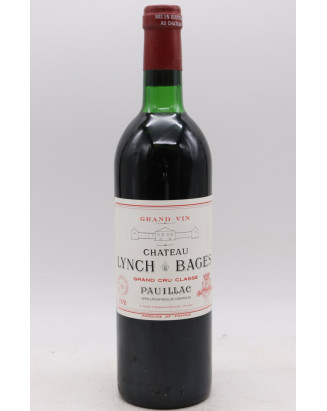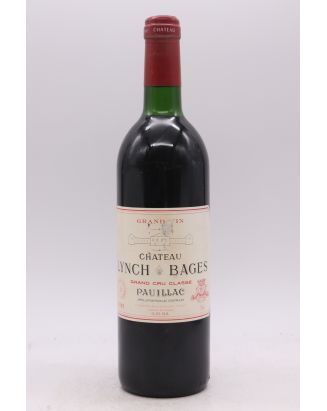








The first mentions of the land of "Batges" date back to the 16th century. Located at the gates of Pauillac, this land has hosted generations of winemakers over the centuries.
In the early 17th century, Jean Déjean, a royal notary, and his brother Pey, a wine merchant, settled in the village of Bages and began acquiring the surrounding lands. The next generation, represented by Pierre Déjean and his son Bernard, completed the formation of the Domaine de Bages, which was sold in 1728 to Chevalier Pierre Drouillard, Treasurer General of Guyenne.
During the 18th and 19th centuries, the Lynch family brought a new dimension to the estate. John Lynch, originally from Galway, took refuge in Bordeaux in 1691. His son, Thomas, acquired the Domaine de Bages on June 9, 1750, through his marriage to the daughter of Pierre Drouillard. Their son, Chevalier Michel Lynch, understood the importance of terroirs, selected the best grape varieties, systematically drained the soils, and invented new viticulture tools.
The property remained in the Lynch family for seventy-five years.
In the 19th century, Bordeaux owners adopted new cultivation techniques, and winemaking methods progressed rapidly. In 1866, Jérôme Cayrou, the new owner of Lynch-Bages, was advised by Pierre Skawinski, a key figure in this technical revolution thanks to the invention of the "new system" vat. For the first time, gravity was used to handle the grapes, with the harvest being hoisted to the crusher located on the upper level and then poured into the vats.
The family's history, marked by perseverance and simplicity, improbable encounters, and travels, reflects that of the Médoc. Their attachment to the vineyard, heritage, and gastronomy is expressed through an art of living the wine, passed down from generation to generation.
Their ancestor, Jean "Lou Janou," left the Couserans valleys near Saint-Girons in Ariège around 1875 to settle in Pauillac and find work. Jean-Charles, the first family member born in Pauillac, initially a baker and then a bank employee, acquired a wine estate in the late 1930s. He proved to be a talented winemaker and established the unique style of Lynch-Bages.
His son André also played a crucial role by rejuvenating and expanding the vineyard. He was the first to promote the wines internationally. Jean-Michel, an engineer in Paris, joined his father in 1973. The facilities and the over hundred-year-old Skawinski winery required modernization, which took fifteen years. Lynch-Bages wines gained consistency and quality.
In 2007, Jean-Charles succeeded his father at the helm of the family estates and launched the renovation project of Lynch-Bages, in collaboration with architect Chien Chung (Didi) Pei. With the 2020 vintage, he opened a new chapter in the estate's history.
Château Lynch-Bages shines with a 99/100 for the 1989 vintage, and 97/100 for the 2016, 2010, 1990 and 2000 vintages, attesting to its excellence according to Robert Parker.
The vineyard of Château Lynch Bages spans 100 hectares, situated on the Bages plateau of the left bank.
The vines are between 30 and 60 years old on average. The vineyard is managed with sustainable practices and consists predominantly of several red grape varieties: 72% Cabernet Sauvignon, 20% Merlot, 5% Cabernet Franc, and 3% Petit Verdot. These grape varieties are typical of Pauillac.
Additionally, a small plot is dedicated to white grape varieties, where Sauvignon Blanc, Sémillon, and Muscadelle are cultivated. These white varieties produce wines with a beautifully aromatic expression.
The vines benefit from a geologically homogeneous terroir and a relatively mild oceanic climate. The gravel plateau features limestone and sandy soils, naturally well-drained thanks to the proximity of the Garonne.
At Château Lynch-Bages, the harvest is done by hand, ensuring the quality of the grapes collected. The berries are carefully sorted before being transferred to stainless steel vats for pump-overs. The spectacular gravity-flow vat is used for vinifications.
After fermentation, the wines undergo racking, maceration, pressing, and malolactic fermentation. The final blend of the vintage is determined by a technical team following numerous tastings.
The Lynch-Bages estate produces around 400,000 bottles each year.
The château markets two Bordeaux red wine blends: the grand vin "Le Grand Vin de Lynch Bages" and, since 2008, a new second wine "Echo de Lynch Bages," replacing the previous second cuvée "Haut Bages Averous," which existed since 1976. Echo de Lynch Bages is made from a selection of plots and the estate's youngest vines. Additionally, since 1990, the Château has also produced a white wine named "Le Blanc de Lynch Bages" (in the Bordeaux Blanc appellation), composed of Sauvignon Blanc, Sémillon, and Muscadelle.
The qualities of Château Lynch Bages are universally recognised, and despite its official ranking as a fifth Cru Classé of 1855, this Bordeaux château is part of the elite wines of the Pauillac appellation. Its characteristics make it a deep and powerful wine with notes of blackcurrant, earth, leather, and tobacco, and it has an ageing potential of 10 to 25 years or more. In its greatest vintages (2015, 2010, 2009, 2005, 2000, 1996, 1990, 1989, 1982), Château Lynch Bages produces exceptional bottles that often feature in the highest-rated wines in primeur tastings. The second wine, "Echo de Lynch Bages," is more approachable, while "Le Blanc de Lynch Bages" is a lively and explosive wine in its youth that can be kept for several years.
Mature Lynch Bages wines pair wonderfully with rib-eye steak, seven-hour lamb, or game!
Discover our 1st Grand Crus Classés and Crus Classés from Bordeaux on our website, with hundreds of references to taste. Find other 5th Grand Crus Classés from Pauillac: Château d’Armailhac, Camensac, Cantemerle, Clerc Milon, Croizet Bages, Grand Puy Ducasse, Haut Batailley, Pontet Canet, and many more!